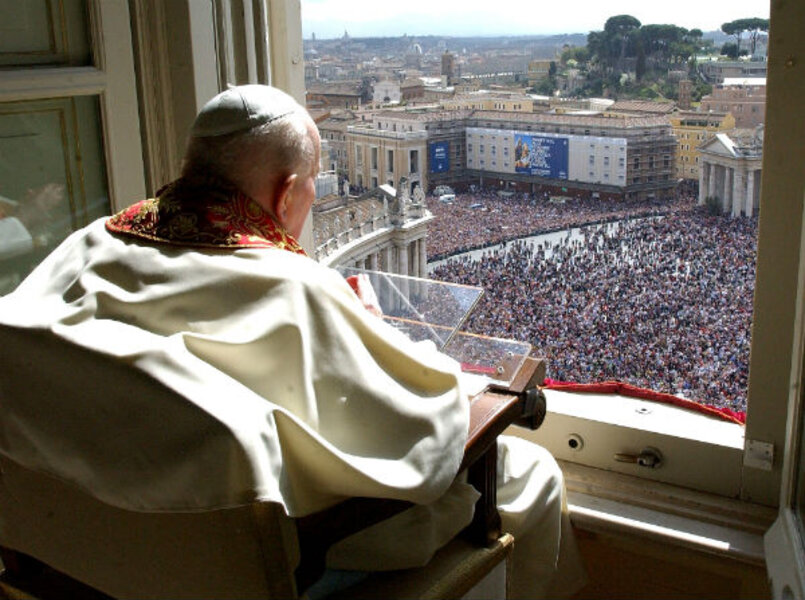Faith tourist: From Easter at the Vatican to a South Pacific church
Loading...
It is said confession is good for the soul, and so I shall “fess up.” I love church hopping, all denominations, observing the diversity with which humankind worships divinity.
As a journalist, I discovered it was a wonderful way to learn how others think and who people are.
I have visited better than half the cathedrals in Britain, sung “Amazing Grace” in the Plains, Ga., Baptist church with Jimmy Carter, and been blessed by Pope John Paul II in St. Peter’s Square among the throngs on Easter morning.
When I was based in Moscow in the 1980s, there were frequent visits to Russian Orthodox Church services. I fondly recall circling outside a cathedral at midnight one Easter Sunday morning, cradling a candle in a frigid wind, chanting in Russian, “Glory to God, Christ is risen. Truly, truly he has risen.” Such fortitude, joy, and faith amid the cold darkness.
My fascination with religious observances is truly ecumenical. I have recited my “Allahu Akbars” in mosques from Britain to the Palestinian territories, across Iraq, and in Muslim Pakistan. I also keep a Jewish kippa, or yarmulke, in my desk.
Worship services offer unique windows on cultures that can sometimes appear veiled to foreigners. You can gauge the influence women have in a society by where they sit in synagogues, mosques, and churches. It’s pretty easy to discern the haves versus have-nots by where people sit, stand, or kneel in parishes, mosques, and temples.
Wherever people of any faith gather there usually surfaces an almost universal need for moments of contemplation, self-surrender. It is as if the adherents of any faith are welcoming a quiet respite from our constant obsession with egos and self.
Sometimes churches are good theater as well. But attending churches new to me is never less than a theological adventure.
My most recent sojourn into the world of worship was the Église Évangélique de Polynésie Français on the South Pacific island of Huahine, in French Polynesia, where I was vacationing.
For one thing, I wanted to learn why a large majority of native Polynesians were Protestant in an overseas territory of largely Roman Catholic France. It turns out that in the early 19th century, British Protestant missionaries got there first.
Outside the small yellow church there were the ubiquitous signs of poverty endemic to tropical climes: peeling paint, spare amenities, and tired concrete. But that was not what I found inside this Polynesian church.
Glancing about at the congregants, I saw the same rich grace and beauty that Paul Gauguin discovered when he came to paint the “innocents.” The young girls, adorned with creamy fresh blossoms in their straight black hair, giggled among themselves.
Western preconceptions of paucity and poverty dissolved amid a luxuriant palette of red, green, and cerulean sarongs worn by a congregation of largely middle-aged women. These were the descendants of the “primitives” that the London Bible Society came to convert in the early 1800s.
A tolling bell signaled the start of the church service promptly at 9 a.m. Moments later in the pew behind me a woman with a hauntingly beautiful, throaty voice sang an a cappella solo of “Abide With Me” in her native Tahitian tongue.
Other Protestant hymns followed in the same deep Tahitian voices summoning reminders of the island’s deep past.
The sermon’s tone seemed slightly revivalist to my wife, but I suspect hellfire and damnation don’t play that well in this Polynesian paradise.
And there remained this riddle. Less than 200 years ago, the Polynesians’ ancestors were practicing cannibalism, infanticide, and human sacrifice. They were waging internecine warfare. So, how did they undergo such a total change of character and become, as described by anthropologist Mark Eddowes, the gentle, happy, loving, joyful Polynesian people of today?
Mr. Eddowes, of New Zealand, believes Polynesians were so decimated by tribal warfare and European diseases that they became highly receptive to Protestant missionaries preaching a merciful, loving God. The islanders eagerly embraced the missionaries’ message: Do good to your enemies, showing them mercy. This new ethic, he says, produced the caring and generous congregants in whose midst we found ourselves.
Understanding some French, I hoped to follow some of the sermon but miscalculated. All 90 minutes of hymns, solos, and sermons were in Tahitian.
But the language of communion was universal, albeit with a South Pacific twist. The traditional bread, representing the body of Christ, was a minced French baguette, and the wine, the blood of Christ, gave me a chuckle. With a quick gulp of watery coconut milk, I became a born-again Polynesian.
Walter Rodgers is a former senior international correspondent for CNN.







